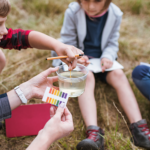
“Luck is a matter of preparation meeting opportunity”
~ Lucius Annaeus Seneca

The ice and snow are starting to melt, the flowers are starting to poke their heads through the dirt, and if your students (and honestly teachers, too) are anything like ours, they’re starting to focus on the golden sunshine of spring break on the horizon. As luck would have it, elementary, middle, and high school Teaching Channel Squadsters came together to explore patterns of inheritance with a clover theme — just in time for St. Patrick’s Day!
Elementary School
Elementary classrooms can investigate fingerprints as they relate to the variation of traits.
The elementary school standards that can be easily applied to this phenomena are:
- 3-LS3-1(Open Link in new tab): Analyze and interpret data to provide evidence that plants and animals have traits inherited from parents and that variation of these traits exists in a group of similar organisms.
- 1-LS3-1(Open Link in new tab): Make observations to construct an evidence-based account that young plants and animals are like, but not exactly like, their parents.

Fingerprints may look similar, but no two fingerprints are the same. Fingerprints develop before we’re born and are composed of several layers of twisted skin that create patterns. All fingerprints are a combination of patterns that have been identified as ridges, loops, whorls, and arches.
According to legend, the leaves of a four-leaf clover represent hope, faith, love, and luck. These are the ingredients that hold my family together and that’s where the inspiration came from for this family investigation. I asked my students to create a four-leaf clover with their family using fingerprints and compare the prints to determine if there are any inherited patterns.
Here is the handout that was sent home for the investigation: My Family Four Leaf Clover(Open Link in new tab)
As an extension of this investigation, you can have a Four-Leaf Clover Hunt
“I have hidden a clover just for you and detective work is what you must do. My fingerprint is unique to me, so don’t be fooled by what you see. Find the print that matches mine and you will truly be just fine. Good Luck!”
Students become clover detectives and move around the classroom trying to match a Leprechaun print to one of the prints in the room. Students will need to pay close attention to patterns and provide evidence for their thinking. Here is the Clover Challenge(Open Link in new tab)
Middle School
Is it Luck or is it a Mutation?
Scientists are often baffled by Trifolium repens L., also known as the clover. This typical three leaf plant can sometimes have a rare, genetic mutation and produce a four-leaf clover. As a matter of fact, according to Guinness World Records(Open Link in new tab), there was a clover with 56 leaves found in Hanamaki City, Iwate, Japan in 2009. The actual genes responsible for this mutation are a mystery, but some scientists believe that the mutation is caused by environmental factors such as weather conditions.

The middle school standards that can be easily applied to this phenomena are:
- LS3.A(Open Link in new tab): Inheritance of Traits — 6-8 genes chiefly regulate a specific protein, which affects an individual’s traits.
- LS3.B(Open Link in new tab): Variation of Traits — In sexual reproduction, each parent contributes half of the genes acquired by the offspring, resulting in variation between parent and offspring. Genetic information can be altered because of mutations, which may result in beneficial, negative, or no change to proteins in or traits of an organism.
- MS-LS3-1(Open Link in new tab): Heredity: Inheritance and Variation of Traits — Develop and use a model to describe why structural changes to genes (mutations) located on chromosomes may affect proteins and may result in harmful, beneficial, or neutral effects to the structure and function of the organism.
Our question becomes:
Does having more leaves on the clover have a harmful, beneficial, or neutral effect on the clover population?
When asking this question, students get caught up in a debate where they can typically justify why it could be harmful, beneficial, or neutral for the plant. However, I try to help facilitate the conversation to the ultimate goal of all living things: survival and reproduction.

When students approach the question with that lens, their conversations tend to be more scientific argument with evidence, as opposed to developing opinions. We can then talk about how more leaves might impact other organisms in its environment, pulling in NGSS standards about ecosystems.
A great way to show students how this works is to create a DNA strand and translate it into amino acids. This helps them make the leap to amino acids sometimes creating physical traits that are expressed, such as three leaves or four leaves. It’s important to tell students that this is a simulation, not actual DNA from a clover.
Notice the DNA for each clover is slightly different (a mutation), which ultimately can cause a different amino acid sequence. What I’ve done with my students is give them some pieces of the information, but not all of the information they will need, and then have them work “forward” and “backward” in the process. However, I’d only do this after practice with other genes, in activities like Snorks(Open Link in new tab).
We could also discuss probability here, as Scientific American(Open Link in new tab) states that only one in 10,000 clover plants actually have four leaves. This can lead to a conversation about randomness and probability, which connects well with Punnett squares. The options are endless!
High School
3 Leaves of the Clover, 3 Dimensions of NGSS
Clover’s Poison Pill: The Genetics and Evolution of Cyanide Production in Clover

While we humans may spend our time combing through our lawns for the elusive four-leaf clover, if you’re a small herbivore, such as a snail or slug, beware — these plants could be toxic.
It turns out that the innocent looking clover plant can produce cyanide. Producing a poison like cyanide is actually a common defense mechanism in plants. Other plants such as apples, almonds, lima beans, and flaxseeds also produce this toxin. Cyanide disrupts cellular respiration and can lead to death.
In clover, the production of cyanide, or cyanogenesis(Open Link in new tab), is controlled by two genes.
- One gene allows the plant to produce cyanide containing sugars which are stored in the plant cell vacuole.
- The other gene produces an enzyme that can break apart the cyanide-containing sugar and release the cyanide poison. This enzyme is stored in the cell wall of the plant cell.
When an unsuspecting herbivore starts munching on this clover, the cell is damaged, releasing both the enzyme and the cyanide-containing sugar, and the reaction between the two molecules releases the cyanide.
In an investigation that combines classic Mendelian genetics, population genetics, and natural selection, students can explore the genetics of clover in their local environment. Using a special test paper, known as Feigl-Anger paper, it can be determined if clover plants contain the gene for the cyanide-containing sugar, the enzyme that breaks down the sugar, or both. The production of cyanide varies by location. Students can look for patterns in the data and explore the advantages and disadvantages of cyanide production in different environments.
Through a grant from the National Science Foundation(Open Link in new tab), teachers can request access to the lab materials for free and students can contribute their research to a national database exploring clover genetics. To learn more, visit The Clover Project(Open Link in new tab).
It would be great to talk in person at NSTA(Open Link in new tab)! A number of Teaching Channel’s Next Gen Science Squad(Open Link in new tab) will be attending Science on My Mind(Open Link in new tab), March 15 – March 18, 2018, where we’ll be learning with you and sharing our experiences. You can find us throughout the conference and at the NSTA Share-a-thon.
Until then, follow us by visiting our Deep Dive(Open Link in new tab) or by engaging with other blog posts(Open Link in new tab) from our NGSS Squadsters. And keep an eye out for our “Squad in Action” videos on Twitter: #NextGenSquadinAction(Open Link in new tab). Sign up here(Open Link in new tab) to get support and resources from the Squad and let us know how we can help










